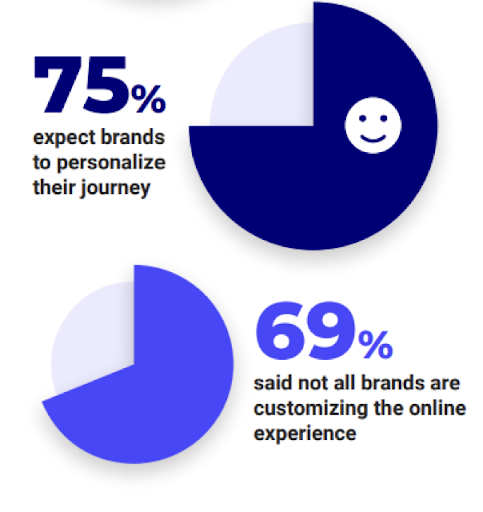Data analysis is an integral part of any experiment. It allows you to quantify your findings, identify trends and insights, and ultimately make better decisions about your online business.
Data analysis is also valuable for understanding how customers interact with your site. By analyzing your ecommerce analytics data, you can determine what works and what doesn’t.
In this blog post, we’ll look at data analysis’s role in ecommerce experimentation.
What is Data Analysis in the Context of Experimentation?
Data analysis is the process of extracting information from data. Data analysis can be described as a cycle of activities and procedures that transform raw data into information, knowledge, and understanding. It uses various statistical methods and tools to extract information from any given data set.
Data analysis in e-commerce experimentation can help you to identify what makes up your potential customers buying behavior, how much a particular factor influences their decision to buy, which websites they visit before making a purchase, how often they visit your website etc.
To understand this better, let us take an example of an e-commerce store where users can browse through products by category or search for specific products by keyword.
Suppose two products belong to different categories but have similar titles and descriptions. The user needs clarification while deciding which product he should buy since both look similar on the website interface.
To solve this issue, we need to analyze the number of clicks each product receives during a specified period (i.e., analyzing clicks per day) to find out which one is being clicked more often than the other so that we can make appropriate changes.
The Role Data Analysis Plays in E-commerce Experimentation
1. Business Growth
Data analysis in ecommerce experimentation helps with business growth by providing insights into customer behavior, customer satisfaction, customer lifetime value, sales performance, and product performance. The data can be analyzed using different analytical tools depending on what you’re looking for.
There are several ways data analysis can help you grow your business:
- Determine which products are most popular among customers.
- Optimize pricing for several products.
- Identify areas where you need improvement or changes in products or services.
- Discover trends in customer behavior so that you can offer more relevant products at better prices.
For example:
If you want to know how long a visitor stayed on your website, you’ll need to use a data analytics tool like Google Analytics or another analytics tool to get this information. This can help you identify areas where visitors are losing interest and optimize your site accordingly so that more visitors stay longer on your site.
Suppose you want to know what people are searching for when they visit your site. In that case, Google Keyword Planner will give you insights into what keywords people are looking for when they search for products similar to yours or related products that they might be interested in buying from you instead of someone else online.
For instance, PayU, a fin-tech company, increased its conversions by 5.8% with the help of data-driven A/B testing.
PayU wanted to maintain an intuitive, straightforward, and convenient checkout process. However, thanks to a form analytics tool, they discovered that many were dropping off from the page, which had a major impact on their sales and revenue graph.
The company made slight changes to its Checkout page form to streamline things using the data collected and conducted an A/B test to validate its hypothesis.
The old checkout page asked users for their mobile numbers and email addresses while purchasing. However, the new checkout page only asked for their mobile number to complete the shopping process.
Have a look at what the control and variation looked like:

Control: Source

Variation: Source
By simply removing the email address field from the checkout page form, they saw a 5.8% increase in conversions as compared to the control.
2. Personalization
If you look at the statistics, 75% of US shoppers expect brands to personalize their journey – while 69% said not all brands are customizing the online experience.
This goes to show just how important personalization is.

(Source)
In e-commerce, personalization is the ability to deliver content and relevant experiences to individual customers. Personalized recommendations, tailored search results, and advertising are some of the most popular uses of personalization.
One of the biggest challenges in using personalization is understanding which elements should be personalized and how they should be customized.
Data analysis plays an important role in this process by helping companies understand their users’ preferences and behavior patterns. Using this information, companies can then decide which elements should be personalized and how they should be customized.
There are many different types of personalization that can be used in e-commerce experiments.
Here are some examples:
- Optimizing the shopping cart experience by providing recommendations based on past purchases or browsing history (including related products)
- Offering personalized recommendations based on site visitors’ social media activity (such as Facebook likes) or demographics (such as age group)
- Personalizing the shopping cart experience by offering different offers based on past purchases
Data analysis can also help companies make sense of large amounts of unstructured data, such as text or images. This can help them better understand their users’ interests, needs, and preferences so that they can provide more relevant content and services.
3. Customer Acquisition and Retention
As an e-commerce business, you may wonder what to do to retain customers. There are many factors at play in customer retention and loyalty, but one of the most effective ways to retain customers is through experimentation.
Experimentation is the process of testing different scenarios to see how they affect your customers’ behavior. You can use this customer data to understand what works best for your business and make the necessary changes so that it does work best for your business.
For instance, Hobson&Company saw that crowd testing resulted in a 10% increase in retention rate.
Clearly, data analysis plays a role in every aspect of your e-commerce business, from understanding your customers to improving your marketing strategies.
Here are just a few ways that data analysis can help you with customer acquisition and customer retention:
- Customer acquisition: You want to acquire new customers without spending too much on advertising campaigns or other marketing tactics. Data analysis shows how visitors interact with your site and what they do when they visit it, so you can use this information to target ads and landing pages that are more likely to appeal to them.
- Customer retention: You also want to keep existing customers happy so they don’t leave and go somewhere else instead. Customer surveys can show what they like most about doing business with you, but if you want to really understand their needs, look at their behavior patterns over time (i.e., what products they buy).
4. E-commerce businesses can quickly analyze visitors’ behavior and make improvements without spending much time, money, or effort.
The role of data analysis in e-commerce experimentation is to provide the best insights for businesses to improve their sites. In today’s digital world, data analytics has become a key tool for e-commerce businesses to create a competitive advantage over their competitors.
By analyzing customer behavior on the website, companies can gain insight into what products are most popular with customers and how they use the site. This information can then be used to optimize the website’s design and functionality so that customers can find what they need easily while browsing.
For example, in one A/B testing case study of Ideall.ro, a Romanian appliance e-commerce store that offers a wide range of top-brand household appliances, the test boosted the conversion rate by 22.26% in just 6 months.
Ideall’s qualitative research (surveys) helped them discover:
- What people liked and disliked about the brand
- The obstacles they encountered on the path to completing a purchase
- Consumer behavior and the demographics that defined them.
Data analysis in e-commerce experimentation helps retailers understand how different design elements affect customer behavior, which allows them to increase sales by improving their site design.
For example, suppose there is a drop-off point in a particular area of your website due to poor navigation or organization. In that case, you can experiment with different designs until you find one that works best for your customers.
5. Helps Reduce Cost
Data analysis in experimentation helps reduce cost and risk by allowing companies to test new ideas before they invest in them. This can benefit small and large businesses alike, as experimentation is important to any company’s growth plan.
However, it’s important to remember that not all experiments are created equal. You need to ensure that your experiment is properly structured so you can extract valuable insights from it later on.
To get the most out of your data analysis, you must first understand how to use it effectively.
For instance, Blockbuster, the multibillion-dollar video rental company, was facing declining popularity in 2000 as customers had to pay high late fines if they couldn’t return the rented movies in time.
They proposed a solution to conduct a simple and low-priced $12,000-only email-as-a-reminder experiment. However, the strategy was cast off as it was too simple.
As an alternative, they implemented a transformative, high-budget strategy to remove fees backed by a big advertising campaign. The strategy was not only unpopular, but it was illegal. The expected legal and business costs surpassed tens of millions of dollars.
You must also understand your data sources.
There are many different types of data sources that you can use when analyzing your ecommerce business data. These include web analytics, social media analytics, transactional emails, customer surveys, and more.
Each source has its advantages and disadvantages when it comes to analyzing your business performance, so learning about each one will help you choose which ones work best for your specific needs.
6. Manage your inventory better.
The data collected during the experiment must be analyzed to make sense of what happened. This can be done by using statistical software or by manually going through all the data points.
However, it is often difficult to identify the importance of different variables in an experiment and determine which variables impact the results.
This is where statistical analysis comes in handy.
By using statistics, we can determine which variables are significant and which ones have no impact on the results at all. This helps us improve our process by identifying which areas need more attention or how we can improve our processes as a whole based on what we have learned from our experiments.
Here are two examples of how data analysis in experimentation helps you manage your inventory better by helping you understand what works best in your business.
- When you want to know what your customers want more of: Conduct an experiment with different flavors or colors of a product and see which one sells better than others. In this case, you can use the A/B testing technique to get more insights into how customers respond to different options offered by you.
- When you want to know what kind of ads work best for your products: You can run multiple variations of ads using any advertising platform (Facebook Ads, Google AdWords, etc.) and see which one performs better than others. In this case, you can use multivariate testing techniques like multivariate testing or A/B testing technique to get more insights into how different ads perform for different audiences.
Wrapping-up
Everyone is different, and what works for one e-commerce site might not work for you. However, I think it’s fair to say that most of us can agree that data analysis plays a very significant role in today’s e-commerce industry.
Collecting data is the first step to taking your website optimization strategy to the next level. It provides you with proof of which experiments worked and which didn’t, and it can help decide future iterations of those that did not work out. You can’t know what works best for your website unless you are regularly gathering data points from your site.



